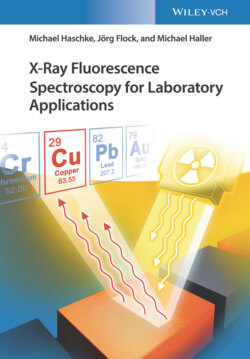Читать книгу X-Ray Fluorescence Spectroscopy for Laboratory Applications - Michael Haschke, Jörg Flock - Страница 38
3.4.2 Preparation by Pouring Loose Powder into a Sample Cup
ОглавлениеPowder-like material can be filled directly into sample cups and analyzed there. In the case of excitation from below, the measurement sample rests on a thin polymer film (see Figure 3.17). Since the sample material can only slightly be compacted by pressure, the sample density can vary for the same sample material. The surface roughness of such samples depends essentially on the grain size. This preparation technique is simple and allows for very fast analyses, but usually does not allow for high precision.
The following factors influence the analysis accuracy most:
The film of the sample cup absorbs both the incident and the analyte radiation. This means that low-energy radiation of lighter elements in particular cannot or can only badly be detected. This can lead to significant analytical errors if the analyzed materials have a high content of light elements. In addition, it is possible that contaminations in the film of the sample cup counterfeit elements or their content in the sample.Figure 3.8 Dependence of fluorescence intensity on the morphology of the sample.Source: Courtesy of S. Hanning, FH Münster.
The measurement often takes place in air, on the one hand, in order to save the time pumping down the sample chamber, but on the other hand also to avoid contamination of the spectrometer by swirling sample particles. Air in the beam path acts as an absorber. The contamination of the spectrometer during evacuation with sample particles can be avoided by covering the sample cup with a lid, see Figure 3.17.
The relatively large surface roughness of loose samples influences the analytical accuracy for light elements. Different information depths of the fluorescence radiation result in their varying absorption.
Owing to the filling process the sample density is not uniform. This significantly influences the reproducibility of the analytical result. This is illustrated in Figure 3.8, which shows the measured intensities of Pb in a loose powder of synthetic granules and correspondingly in a pressed pellet of the same material.
This type of sample preparation is usually used for waste or secondary raw materials. High analytical accuracy is not expected here in the first place due to the low reproducibility and representativeness of the sampling. Variations of the analytical results caused by this simple preparation technique are still small compared to the variations generated by the actual sampling and are therefore negligible. Typical uncertainties for the measurement of loose powder samples are in the range of 3–5% relative to the main components; accordingly, for traces they are larger and depend on the element, the matrix, and the grain size.
It needs to be considered that in case of wavelength-dispersive spectrometry (WDS) instruments the film is thermally stressed by the high excitation intensity, i.e. long measurement times should be avoided.
